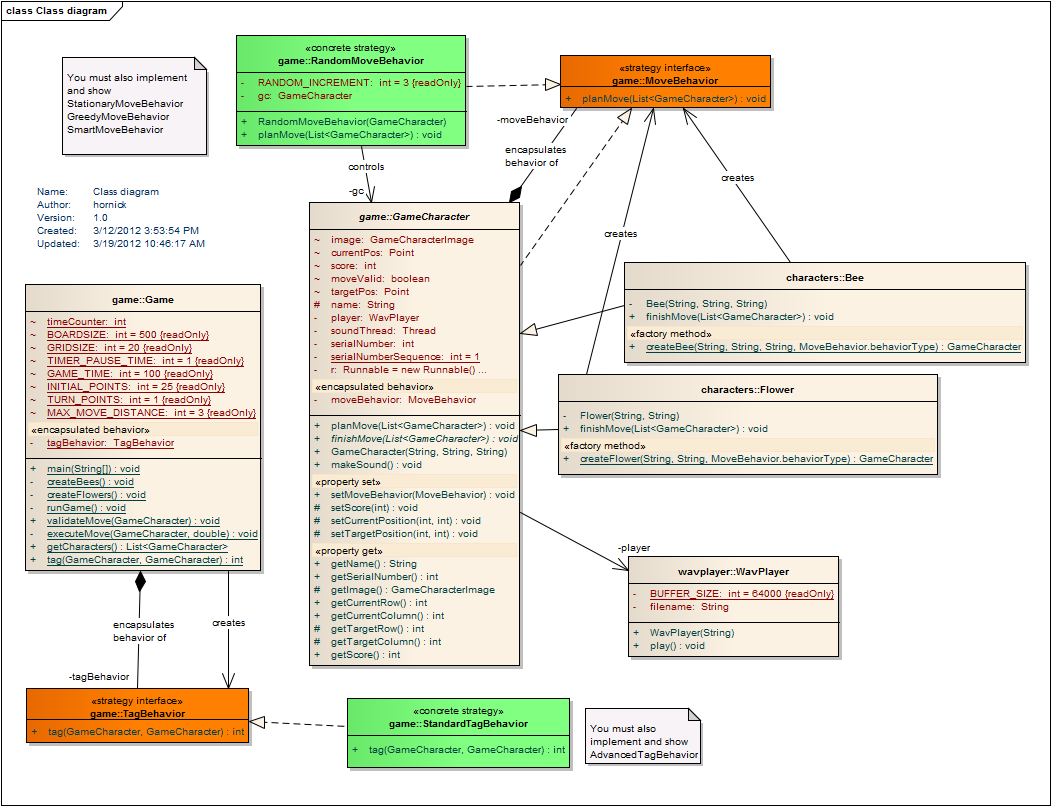This is an old version of this course, from Winter 2013-2014. A newer version is avaliable here.
The objective of this lab is to refactor the Angry Bees simulation such that both the Game and GameCharacter classes encapsulates behaviors the Strategy Pattern, and incorporate the Factory Method pattern into the Bee and Flower classes to create those characters.
Assignment
Download the TagBehavior.java and MoveBehavior.java files containing the interfaces that define the MoveBehavior and TagBehavior strategies. Since these are just interfaces, you'll have to provide the implementation of the concrete strategies in concrete classes. You will need to create 4 classes that implement the MoveBehavior interface; these are
- RandomMoveBehavior - as demonstrated in lecture, this class implements the random move planning behavior originally implemented in the Bee class.
- StationaryMoveBehavior - this is a "null" behavior that Flowers use.
- GreedyMoveBehavior - this is the behavior which causes the character using this behavior to move to the Flower with the highest number of points.
- SmartMoveBehavior - this is the behavior which causes the character to move to the closest Flower with at least 3 points.
You will need to implement 2 classes that implement the TagBehavior interface; these are:
- StandardTagBehavior - this is the behavior originally implemented in the Game class.
- AdvancedTagBehavior - this is a new behavior that should
implement an algorithm similar to StandardTagBehavior, but also:
- when a Bee tags another Bee, this game should "steal" half the points from the tagged Bee and award them to the tagging Bee 20% of the time (use a random number generator to do this efficiently), and do nothing the other 80% of the time.
- when a Bee tags a Flower whose name is "nightshade", 50% of the time the game should change the behavior of the tagging Bee so that it subsequently uses RandomMoveBehavior and award the Bee 0 points (although the Flower's score should decrease to 1 point as usual). The other 50% of the time, no behavior change should be made, but the Bee should still be awarded 0 points along with the Flower's score reducing to 1 point.
- when a Bee tags a Flower whose name is "daisy", the game should award points as usual, but also change the behavior of the tagging Bee so that it subsequently uses SmartMoveBehavior.
- when a Bee tags a Flower whose name is "rose", award points as usual and change the behavior of the tagging Bee so that it subsequently uses GreedyMoveBehavior.
The class diagram representing this application's structure after the lab is as follows (the different colors serve only to differentiate strategy interfaces from strategy implementations):

To create Bees in this version of the game, note that you must modify the Bee class to implement a Factory Method named createBee(), which handles the creation of the Bee itself as well as a specified behavior (supplied to createBee() as an enum). Similarly, to create Flowers, you must modify the Flower class to implement a createFlower() Factory Method.
In the Game class, you must modify Game to implement to use the TagBehavior
interface, create an instance of StandardTagBehavior in the main()
method, and set the tagBehavior attribute to initially reference
that instance. The Game.tag() method thus initially uses
StandardTagBehavior whenever that method is called from a GameCharacter's
finishMove() method. You must modify the Game class's runGame()
method to switch to use AdvancedTagBehavior when
the remaining time is 80% of the original game time. No special Factory Method
is needed to create or switch these behaviors.
Lab Submission (due 11pm Monday Week 3 via SVN)
You are expected to work on these labs individually. Although discussion with others is encouraged, your final code should be entirely your own.
Although there is no in-lab completion for this lab, I expect you to devote lab-time to working on the lab. Please contact me before leaving the lab. If someone does leave the lab early (or otherwise "check out") without first "checking in" with me, I'll have to figure out what to do in that situation. Let's avoid this entirely. Talk to me first.
Your assignment will consist of:
- your completed implementation, containing your fully-commented,
functional classes.
- a reverse-engineered UML class diagram, similar to the one shown above, but including the additional concrete Strategy classes indicated. Be sure to create ALL associations (similar to those shown), as well as the <<stereotypes>> as appropriate. Also, add a Diagram Note as shown above - your name and date will be automatically incorporated into the note. Create a .pdf file containing the class diagram by using the File/Print command and printing to a PDF printer driver (e.g. CutePDF Writer).
Submit your assignment by committing your projects entire source folder to your SVN repository in a top-level project named "Lab2" (no trunk, branches, or tag is needed). The .pdf image file should be directly in the Lab2 folder, but all code should be in a subfolder of Lab2 named "src". Do not commit any binary files (such as .class files), and do not commit the EA project file.